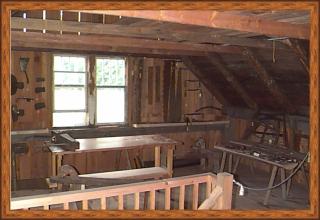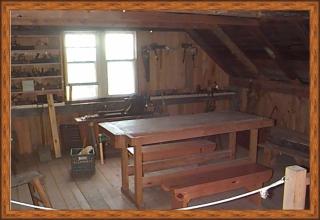
 Taylor Barn Carpenter's
workshop:
Taylor Barn Carpenter's
workshop:
The upstairs portion of the Taylor Barn in the Cumberland Museum illustrates what a carpenter's workshop was like in the 1930s. In the past the carpenter played an instrumental part in the construction of the building. With the changing of technology, and the development of better construction methods, the carpenter's expertise in the construction of houses has became more specialized.
A 1930s carpenter's work would have also extended to interior jobs, like making door frames, cabinets, countertops, and assorted molding and trim. Most of the skill was in giving the house a finished look.
The standard hand tools used by a
carpenter would have been hammers, pliers, screwdrivers, and axles for setting screws, and
punching guide holes. Planes and chisels would also have been used. Planes are hand
held blades used to reduce and smooth wood surfaces, and chisels are blades that can be
hit with a mallet to cut out forms in wood. Hand saws would have been used to cut the
wood. The crosscut saw cuts across wood grain and the rip saw cuts with the grain.
Tenon and dovetail saws were used to make cuts for joints, and a keyhole saw to cut out
holes. Try the links below to learn more about some of the carpenter's tools!
setting screws, and
punching guide holes. Planes and chisels would also have been used. Planes are hand
held blades used to reduce and smooth wood surfaces, and chisels are blades that can be
hit with a mallet to cut out forms in wood. Hand saws would have been used to cut the
wood. The crosscut saw cuts across wood grain and the rip saw cuts with the grain.
Tenon and dovetail saws were used to make cuts for joints, and a keyhole saw to cut out
holes. Try the links below to learn more about some of the carpenter's tools!
Artifacts:
![]()



